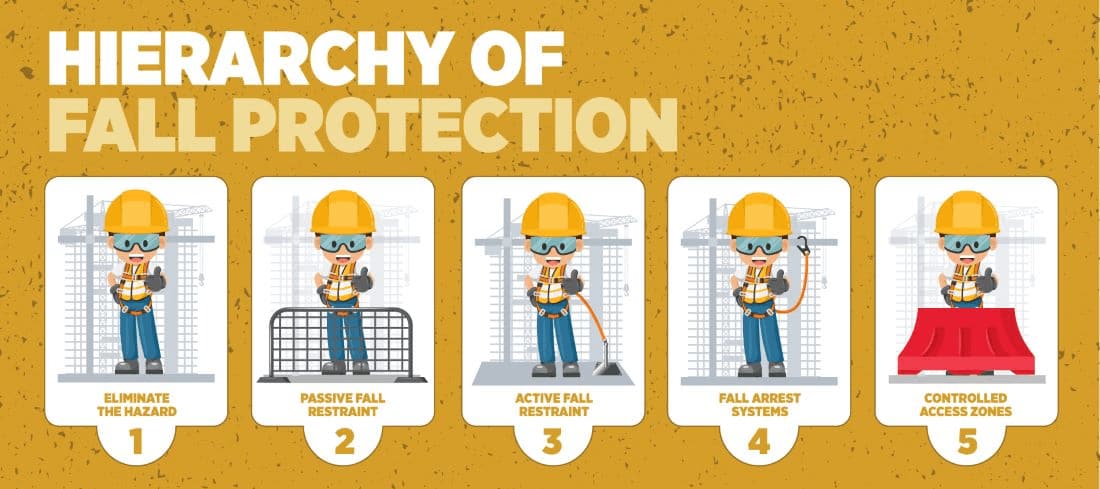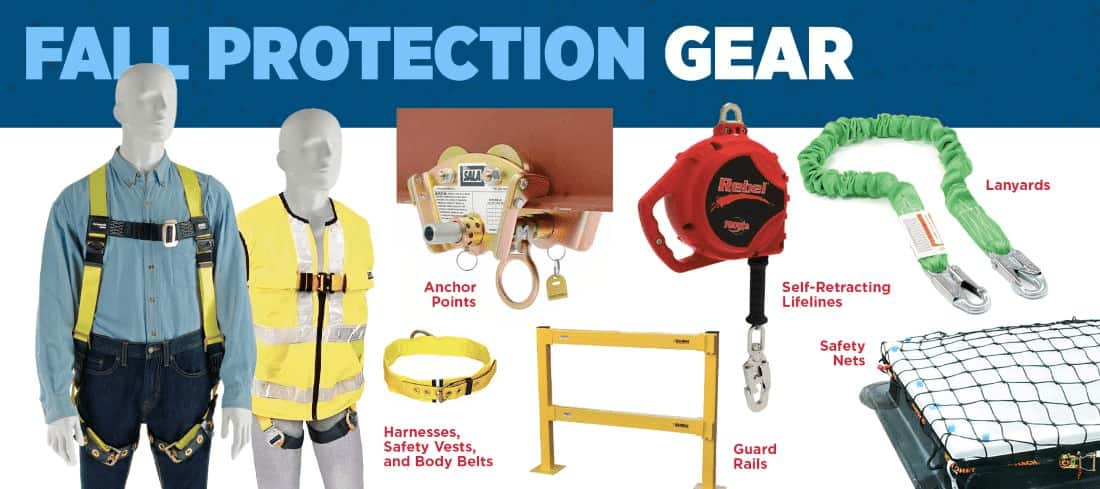On May 1, 2023, the US Department of Labor announced that the Occupational Safety and Health Administration (OSHA) has begun a National Emphasis Program to prevent falls, the leading cause of fatal workplace injuries. Falls are the most frequently cited violation by OSHA in the construction industry. The emphasis program will focus on reducing fall-related injuries and fatalities for people working at heights in all industries. With this renewed national emphasis, now is the perfect time to look at your own fall protection needs.
According to the US Bureau of Labor and Statistics (BLS), in 2020 there were 351 fatal falls to a lower level out of 1,008 construction fatalities. The American National Standards Institute has updated its rules and standards for self-retracting devices to address the issue- see the link at the bottom read more about the new rules.
HONEYWELL SAFETY BULLETIN: NEW ANSI STANDARDS FOR FALL PROTECTION
Regardless of your industry, worker safety is a top priority. This is especially true if your business puts workers at high altitudes. Whether your team is climbing trees, ascending scaffolding, or really doing anything more than a few feet above the ground, preventing accidents is essential. In combination with extensive training and good oversight, high-quality fall protection gear & other safety equipment is your best means of mitigating risks and ensuring every one of your valued team members works in a safe and productive environment.
Since falls are one of the leading causes of death in general and especially in the construction industry, OSHA recommends fall protection for any workspace 4 feet and higher for general industry and six feet or higher for the construction industry. In 2022, fall protection was the leading cause of violations with 5,260 separate incidents of inadequate fall protection. While avoiding workplace accidents and OSHA fines are obviously motivating, investing in safety gear like fall protection shows your team where your priorities lie – with their safety.
Best Practices
To get started, here are a few general key tips to providing effective fall protection at your facility:
- Create a secure work area
- Prioritize training
- Have the right equipment ready
- Make accountability a habit
The important thing to remember is that prevention is the key. By investing some time and money in creating good systems and oversight habits, potential disasters can often be avoided, and lives can be saved. Always have a plan. Luckily, OSHA provides guidance for best practices in fall protection with the hierarchy of controls.
Hierarchy of Controls

After conducting an extensive evaluation of the workspace to identify potential hazards, the hierarchy of controls is a series of steps to protect your workers from harm at every stage.
Step 1: Elimination: removing or avoiding the fall hazard altogether.
Step 2: Prevention: if removing the hazard is not possible, the next step is passive fall protection measures such as guardrails or other barriers to prevent workers from moving into the area with the fall risk.
Step 3: Restraint: utilizing personal protection equipment (PPE) designed to restrict the worker’s range so they cannot physically travel to the fall hazard.
Step 4: Arrest: where restraint is not possible, a fall arrest system can be used, including fall protection equipment and protective gear such as fall protection harnesses, lanyards, or self-retracting lifelines.
Step 5: Administrative Controls: work practices or procedures that increase a worker’s awareness of a fall hazard, such as safety monitors (i.e. a person guarding the area), warning lines, warning horns, designated areas, or control lines. It should be noted that administrative controls are the least preferred method of protection because they do not provide a physical or positive means of protection.

Training and Inspection
As we know, a system is only as effective as the people using it. For your fall system to be effective, your workers need to be trained and your equipment needs to be inspected. By OSHA standards, every worker expected to wear fall protection PPE must have documented annual training. Also, personal fall arrest systems shall be inspected prior to each use for wear, damage and other deterioration and have an annual documented inspection by a competent person. Defective components shall be removed from service immediately. Use of subpar fall protection equipment is unacceptable.
Focus on Quality
When it comes to fall protection gear, quality is key. Not all fall protection gear is created equal. Investing in high-quality gear can make all the difference in keeping workers safe. Human safety is NOT an area where you want to scrimp and save. Your workers deserve the very best in protection. Luckily, you don’t have to choose between safety and savings. By shopping smart, you can equip your crew with effective high-quality fall protection for reasonable prices.
There are several factors in choosing the right fall protection gear for your crew, including type of work, weight capacity, adjustability, and comfort. Let’s take a closer look at the types of fall protection gear you need to equip your workers for safety:

A safety harness is the most important piece of fall protection gear. Upon a fall, the harness distributes the impact over the entire body. There are a range of harness types to meet different needs, including full-body harnesses, construction harnesses, and safety vests.
Full-body harnesses are suitable for jobs that require a lot of movement, such as construction, painting, and maintenance. They have multiple attachment points for lanyards and are adjustable to fit different body types. Some of the harnesses come with a dorsal D-ring for fall arrest, while others have side D-rings for work positioning.
Construction harnesses are designed specifically for the construction industry. They usually have a front D-ring for ladder climbing and a back D-ring for fall arrest. They usually come with a dorsal D-ring for as a fall arrester and are adjustable to fit different body types.
Safety vests are a convenient option for jobs that require intermittent fall protection, such as roof inspection or maintenance. They are lightweight and easy to put on and take off. They usually come with a dorsal D-ring for fall arrester and are adjustable to fit different body types.
For a smaller risk job, a simple body belt may be helpful. Designed to match safety with usability, a body belt can double as a tool pouch carrier - giving you the security of a harness with an added layer of flexibility. It can also be paired with a larger harness system for backup protection.
Global Industrial also carries a wide range of harness accessories, including D-ring extenders, suspension trauma straps, positioning belts, soft sling seats, and anything else you may need. For an all-in-one system, keep it simple with the comprehensive fall protection kits.
A harness lanyard is a flexible line of webbing or cable that connects the harness to the anchor point. Lanyards range in type and size depending on different needs, including shock-absorbing lanyards, positioning lanyards, and restraint lanyards.
Shock-absorbing lanyards are designed to reduce the impact of a fall. They have a tear-away design that reduces the risk of injury to the worker in the unfortunate event of a fall. They are suitable for jobs that involve a lot of movement, such as construction, roofing, and maintenance.
Positioning lanyards keep the worker in a fixed position while working at height. Adjustable straps allow the worker to move up and down the rope, making them ideal for working on scaffolding or other elevated platforms.
Restraint lanyards prevent the worker from reaching the edge of a fall hazard. With a fixed length attached to an anchor point on the other side of the fall hazard, they are perfect for jobs that involve working near the edge of a roof or other elevated surface.
Lanyards can be made from a variety of different materials, including nylon, polyester and Kevlar. Nylon is the most common material used for harnesses and lanyards. It is strong, durable, and relatively inexpensive. Polyester is another common material used for fall protection gear. It is slightly more expensive than nylon, but it is also stronger and more resistant to abrasion. Kevlar is the strongest and most durable material used for fall protection gear. It is also the most expensive.
In addition to worker falls, you want to reduce the risk of dropping tools and equipment, particularly if you are working in a populated area with people passing below. Global Industrial provides a wide variety of lanyards and tethers to secure tools and equipment to minimize the potential of damage and injury.
Anchor Points:
An anchor point is a secure attachment point for the lanyard or lifeline, designed to keep the lanyard in place in case of a fall. The type of anchor point largely depends on the type of job needed.
Roof anchors are designed to be installed on the roof of a building to provide a secure attachment point for the lanyard or lifeline. There are several different types of roof anchors, so your choices will be dictated by the particular roof conditions of your specific job.
Concrete anchors are installed in concrete or other solid surfaces and provide a secure attachment point for the lanyard or lifeline. They come with a bolt or wedge anchor and are suitable for jobs that involve working on bridges or other concrete structures.
Beam anchors are attached to a structural beam and provide a secure attachment point for the lanyard or lifeline. They come with a clamping mechanism that allows them to be attached to different beam sizes.
Portable Anchor Frames provide tremendous flexibility for working in difficult conditions. Rather than rely on an existing or incomplete structure, these mobile tools enable you to make the most of your workspace while providing the best possible security against disaster.
Self-Retracting Lifelines (SRLs): Self-retracting lifelines (SRLs) are another type of fall protection gear that are used in a variety of industries. These devices are designed to arrest falls and can be particularly useful for those working at height in areas where there is little or no overhead anchorage. SRLs are designed to automatically retract and keep the lifeline taut, which helps to reduce the risk of tripping or snagging.
SRLs come in different lengths and can be customized to fit specific job requirements. For instance, a construction or electrical worker may need to move around frequently or work in different locations. SRLs can be a great option. Horizontal and vertical lifelines can also be a great choice for maximizing mobility while also prioritizing safety. Global industries also carries a variety of rope grabs and clamps to augment virtually any safety line system.
Safety Nets: Safety nets are an effective system to catch workers who may fall from heights, providing a fail-safe to any primary fall protection equipment. Safety nets are made from a variety of materials, including nylon, polypropylene, and polyester, and are designed to withstand the weight of a falling worker. They are also available in different sizes and configurations, making it easy to find the right safety net for the job.
The good news is tragic workplace accidents are largely preventable. Fall protection gear - in combination with the proper ladders, scaffolding, and effective training - can be a genuine life saver. With all the high-quality gear available, there is no reason to leave your workers unprotected from fall risk. Protect your greatest asset by equipping them with the best tools. The Global Industrial team is ready to assist you, so reach out and gear up!
The information contained in this article is for informational, educational, and promotional purposes only and is based on information available as of the initial date of publication. It is the reader’s responsibility to ensure compliance with all applicable laws, rules, codes and regulations. If there is any question or doubt in regard to any element contained in this article, please consult a licensed professional. Under no circumstances will Global Industrial® be liable for any loss or damage caused by your reliance on this article.